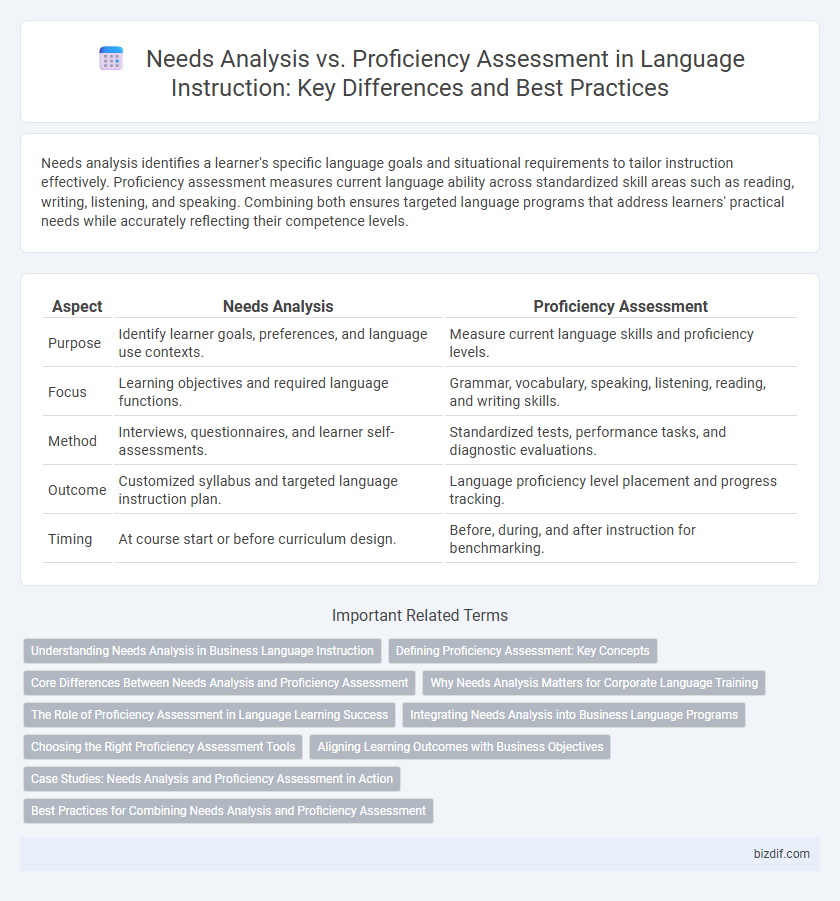Needs analysis identifies a learner's specific language goals and situational requirements to tailor instruction effectively. Proficiency assessment measures current language ability across standardized skill areas such as reading, writing, listening, and speaking. Combining both ensures targeted language programs that address learners' practical needs while accurately reflecting their competence levels.
Table of Comparison
| Aspect | Needs Analysis | Proficiency Assessment |
|---|---|---|
| Purpose | Identify learner goals, preferences, and language use contexts. | Measure current language skills and proficiency levels. |
| Focus | Learning objectives and required language functions. | Grammar, vocabulary, speaking, listening, reading, and writing skills. |
| Method | Interviews, questionnaires, and learner self-assessments. | Standardized tests, performance tasks, and diagnostic evaluations. |
| Outcome | Customized syllabus and targeted language instruction plan. | Language proficiency level placement and progress tracking. |
| Timing | At course start or before curriculum design. | Before, during, and after instruction for benchmarking. |
Understanding Needs Analysis in Business Language Instruction
Needs analysis in business language instruction identifies learners' specific goals, job-related tasks, and communication challenges to tailor training effectively. It gathers data on skill gaps, workplace contexts, and language functions essential for professional success. This targeted approach ensures course content aligns precisely with the demands of learners' business environments.
Defining Proficiency Assessment: Key Concepts
Proficiency assessment measures a learner's actual language ability by evaluating skills such as speaking, listening, reading, and writing through standardized tests or performance-based evaluations. It provides quantitative data on language competence levels, typically aligned with frameworks like CEFR or ACTFL. Understanding proficiency assessment is crucial for setting realistic learning goals and tailoring instructional strategies to meet demonstrated skill levels.
Core Differences Between Needs Analysis and Proficiency Assessment
Needs analysis identifies learners' specific language goals, preferences, and contextual requirements to tailor instruction effectively. Proficiency assessment measures learners' current language skills against standardized criteria to determine their competence levels. The core difference lies in needs analysis focusing on personalized learning objectives, while proficiency assessment emphasizes objective evaluation of language ability.
Why Needs Analysis Matters for Corporate Language Training
Needs analysis identifies the specific language skills and workplace contexts crucial for effective communication within a corporation, ensuring training is tailored to actual job requirements. It guides the development of customized learning objectives that align with business goals, enhancing employee productivity and engagement. Proficiency assessment alone measures current skill levels but lacks the insight needed to design relevant, impactful corporate language programs.
The Role of Proficiency Assessment in Language Learning Success
Proficiency assessment plays a critical role in language learning success by providing accurate measurement of a learner's current skill level, which informs targeted instruction and personalized learning plans. Unlike needs analysis that identifies learner goals and contexts, proficiency assessments use standardized tests and performance evaluations to benchmark progress and pinpoint areas requiring improvement. Consistent proficiency assessments enable educators to track development, adjust teaching strategies, and ensure learners achieve measurable language competency outcomes.
Integrating Needs Analysis into Business Language Programs
Integrating needs analysis into business language programs ensures tailored curriculum development that addresses specific workplace communication challenges and industry terminology. This approach enhances learner engagement and outcomes by aligning language skills with job roles, goals, and organizational objectives. Conducting comprehensive needs analysis before proficiency assessment allows programs to focus on relevant competencies, creating practical and measurable learning pathways.
Choosing the Right Proficiency Assessment Tools
Selecting the right proficiency assessment tools depends on accurately identifying learner goals, language contexts, and skill requirements revealed through thorough needs analysis. Tools like the ACTFL Oral Proficiency Interview (OPI) or the CEFR-aligned tests provide measurable data tailored to specific learning outcomes and teaching objectives. Prioritizing assessments that align with curriculum goals ensures effective tracking of language development and targeted instructional strategies.
Aligning Learning Outcomes with Business Objectives
Needs analysis identifies specific learner requirements by assessing job roles and organizational goals, ensuring training content is relevant to business objectives. Proficiency assessment measures existing language skills to establish baseline competencies and tailor instruction effectively. Aligning learning outcomes with business objectives maximizes training ROI by targeting skill gaps that directly impact workplace performance.
Case Studies: Needs Analysis and Proficiency Assessment in Action
Case studies in language instruction illustrate the distinct roles of needs analysis and proficiency assessment, where needs analysis identifies specific learner goals and contextual demands, guiding curriculum design and resource allocation. Proficiency assessment measures learners' current language abilities, providing a benchmark for tracking progress and tailoring instruction to individual skill levels. Integrating both approaches ensures targeted, effective language programs that address learners' immediate needs while monitoring development over time.
Best Practices for Combining Needs Analysis and Proficiency Assessment
Integrating needs analysis with proficiency assessment offers a comprehensive approach to language instruction by identifying learners' specific goals and measuring their existing skill levels. Best practices involve using diagnostic tests alongside surveys or interviews to gather detailed learner profiles, ensuring tailored curriculum development. This combined methodology enhances targeted instruction, maximizes learner motivation, and streamlines progress tracking.
Needs Analysis vs Proficiency Assessment Infographic

 bizdif.com
bizdif.com